Fifteen years after the release of their game Legend on Super Nintendo, 1UP has had the opportunity to ask questions to the small French team of Arcade Zone. Carlo Perconti was in charge of the programming and sound, Lyes Belaidouni of the graphics and animation, while they developed the concept together.
· Click here to read the original interview in French language ·
Details on Arcade Zone are scant, how was the company set up and who made up the development team ?
Carlo Perconti: Well, primarily, Arcade Zone Ltd was born from the association of three persons: Lyes Belaidouni, Gabriel Gary and myself. At that time, I was working as a freelancer for several French companies, among which Loriciels and Titus. Lyes Belaidouni was a graphic artist whom I met for the first time at Titus; I seem to recall Gabriel Gary was also working there in the foreign sales department.
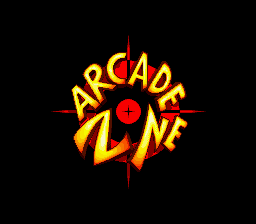 Our connection was made through Lyes actually, we thought that we could combine our respective skills and launch into the development of our own game creations. I believe that, at that time, we were all more or less "stuck" in what we were doing and we had the common will to make something of our own. The decision was thus made to form Arcade Zone, in London.
Our connection was made through Lyes actually, we thought that we could combine our respective skills and launch into the development of our own game creations. I believe that, at that time, we were all more or less "stuck" in what we were doing and we had the common will to make something of our own. The decision was thus made to form Arcade Zone, in London.
Why London ? Simply to be in the key location, where Nintendo's offices were located, because we were not only wishing to work on a Super Nintendo project as a developer but also as a publisher, which, in terms of bank financing and trust, was far from being easy. And so we invested our savings to build up the necessary capital in order to acquire the publisher license from Nintendo. This is when the adventure started, with our trio made up of Lyes as the graphic designer, me as the programmer and Gabriel as the sales manager.
Lyes Belaidouni: I worked at Titus for about a year and a half where I quickly became lead graphic artist. I was involved with most productions which were for Amstrad, Amiga and NES ! At the time they developed mostly racing games, later on I could contribute with my action-oriented style to their productions, such as Prehistoric Man. Unfortunately they had cold feet and hesitated to move to Super Nintendo, that was one of the reasons for my departure.
From my perspective, Arcade Zone was made in two phases. I did all I could to go to the Las Vegas game show, the CES. Once there it was a revelation, like finding the Grail. Back in Paris, I said to myself that next year I would like to go there again, but this time with my game.
I explained to Carlo the fantastic opportunities we could have on game consoles. No sooner said that Carlo proposed me to quit Titus and begin our own collaboration on Super Nintendo. I must point out that Carlo had been in the game industry for longer than I had and had scored a smashing success at the time on Amiga; we fully benefited from his professional contacts.
Later, we completed a commissioned work for Loriciel which enabled us to self-finance. The second phase was to integrate Gabriel Gary in our team for managing the business side of things. Arcade Zone was born !
How did you get the idea to create a beat'em up only for the Super Nintendo ?
Carlo Perconti: The idea came naturally. Lyes and I were — and still are — fans of arcade games, at that time in café's backrooms, cabinets where you shoved in a few francs to try to beat your own record. Truly, we spent there a great deal of time, to observe what was new, out of the ordinary and what we liked. Back then, the greatest innovations were made in beat'em ups, Lyes and I loved to play that kind of games, therefore, I won't hide it :) we made the game we wanted to play. It's a little bit selfish but this is how we decided to make our "Legend".
Lyes Belaidouni: It's true that our strength was that we were going at a style that neither the Europeans, nor the Americans dared to develop. We have spent hours and hours in arcade game rooms, wearing out our shoes and spending all our francs ! I also remember we were trying to discreetly record scenes from a Capcom game, but the problem was that at that time camcorders were not discreet; we were kicked out like dirty bums, the owner must have thought we were spies... He probably didn't declare all of his machines ! lol
Which beat'em ups, or more generally which games, which works, have influenced you when creating Legend ?
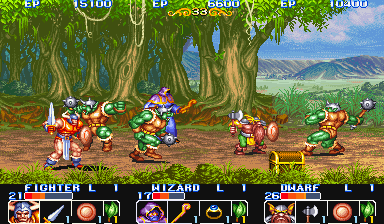
The King of Dragons, arcade game (CPS-1)
Carlo Perconti: Without a doubt, The King of Dragons by Capcom, it was my (I would say "our") reference at all times. We enjoyed everything in that game, the atmosphere, the graphics... there was something special about it that encouraged us to work in that direction. Capcom introduced some really great beat'em ups. You have to remember that back then there was no French team making beat'em ups; we thought we could add our "style", our "touch" to the genre.
Lyes Belaidouni: Also from Capcom, I was fond of the game with the knights of the round table and Lancelot (Editor's note: Knights of the Round, which was also ported from the arcade to the Super NES). And we really loved Golden Axe from Sega.
Legend seems a gigantic game for involving only two persons. How long did it take to develop and did you encounter any particular obstacles ?
Carlo Perconti: If I remember correctly, we worked together for 2 or 3 months, Lyes and I. We were highly motivated, we worked like crazy :) but we didn't feel the weight of labour on our shoulders, we were very enthusiastic and we congratulated one another at each new success in the development: the first on-screen sprite, the first map, the first scrolling, etc...
Technically, everything had to be done, we had no "library" (editor's note: a set of subroutines to simplify the coding) for the Super Nintendo and we had to create it all. Our greatest concern was the hardware limitations and that we could not put more than 64 sprites on the same raster line, so we had to find compromises. It was a constant struggle because Lyes continued to output graphics at lightning speed, always better-looking, always bigger, and I had to find a way to display all that while staying at 60 frames per second.
So I first developed a sprite generator, in order to optimize the number of hardware sprites by character. Then, I made a dynamic programming system of the tiles for the background map, and I also created a map editor specifically for the Super Nintendo, with several planes, several scrolling speeds, tile animations 16x16, 8x8, etc... And on top of that, there was no C or C++ language, it was all in assembly language on the Super Nintendo. Thinking back, the work conditions were really tough :)
Lyes Belaidouni: Let's not forget that at the time we didn't have a Nintendo software development kit, Carlo had an EPROM reader ! For each new test we were forced to record the program on an EPROM, then to put it on some kind of hacked cartridge. We had gambled we would develop a game in a non-official way, which was risky.
For my part, I had to deal with technical constraints: number of colours per tile, total number of tiles, etc... I drew all my backgrounds and my characters on a graphic editor by pixel. It was Deluxe Paint on Amiga. Pixel by pixel ! So, for a background for instance, I drew the whole terrain on one page made of several screens. Then I used a background reconstitution tool developed by Carlo on PC. For the sprites, I used the same software and I drew the different animations frame by frame. For each new background I had new ideas and every time I had to negotiate with Carlo ! lol
It's true that people had a hard time believing just the two of us could have done so much. Beside the fact that we were working really, really fast, what was important was to have a good work method right from the start and to keep at it. Ah, one last difficulty and not the least was the size of the cartridge ! Indeed, we had to decide beforehand its memory size and not get it wrong: 4, 8 or 16 megabits for the largest ones. That affected the production cost, of course we chose the smallest one ! (Editor's note: as a matter of fact, Legend fits on a 8-megabit Super Nintendo cartridge, that's 1 megabyte, like Zelda)
Are you satisfied with it, is there anything you would have liked to change or add ?
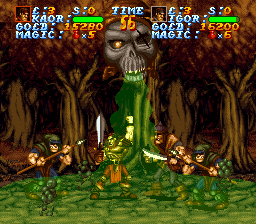
Eyes' delight with Legend
Carlo Perconti: We were very satisfied with it. We wanted more speed in the animations but that was tied to the hardware limitations of the Super Nintendo. However we were delighted with the result, we told ourselves that for a first attempt with a beat'em up game, we did pretty well. Perhaps our nicest memory comes from the CES, we were showcasing Legend and people from Capcom were showcasing King of Dragons (editor's note: when it was ported on the Super NES), so having them come to us and look at our game was the greatest of all satisfactions...
Lyes Belaidouni: You know, if we just did what we wanted we would keep adding or modifiying things eternally ! A time comes when you need to stop, and besides we had an obligation, to get the game released.
Why didn't Legend come out in Japan and did it sell well in the two other regions ?
Carlo Perconti: I think at that time we didn't have any contact with the Japanese and the "Japanese games for the Japanese market" lobby was very, very powerful. I wasn't aware of any beat'em up made in Europe which had sold in Japan, it even seems to me that the question of selling in Japan wasn't in anyone's mind then. The game sold well but I could not tell how much because our deal with Sony was a one-off payment with no royalty.
Lyes Belaidouni: Even for European or American big productions it was difficult !
In Europe, it was distributed by Sony Imagesoft. Why Sony and do you think they did their job well ? Personally, if I clearly remember seeing Cliffhanger and Dracula on the retailers' shelves, two second-rate games from Sony, I do not recall seeing Legend even though I was looking forward to it.
Carlo Perconti: Why Sony ? Quite simply because they made the best offer. Arcade Zone was located in London and so was Sony. The dealings had been hard, but Gabriel did well and managed to sign Sony as a distributor. Now, when looking back, we know why Sony was pursuing the distribution of Nintendo games so actively: it was to push in their own machine, the Playstation, and at the same time affect Nintendo's sales. I think that unfortunately Legend was distributed with that state of mind and was not necessarily promoted as it should have been. When we realized that, it was much too late: Sony already had a hand in the European distribution and was launching their own game console which was to become the beginning of their great success.
Lyes Belaidouni: And there were also backstage gossips hinting Sony promoted some of his buddies' games more than some others. If they were favorable to you or if you had some contacts at Sony, even a mediocre game was more likely to get released and to be supported !
Likewise, in the press, the French origin of the game didn't appear to be put forward unlike Mr. Nutz for instance which received broad coverage from the media. Why is that ?
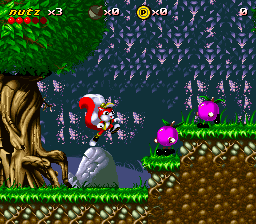
Mr. Nutz, Ocean's French superstar
Carlo Perconti:
Arcade Zone being in London, I think it might have diverted the attention of journalists at the time of Legend. Perhaps the most important though, is that the beat'em up genre was not all that well received by critics of the time, it was merely some "brutal games with no technique" and instead they were entirely focused on cute platform games of which Mr. Nutz is the perfect example; we were the ugly duckling with a type of game that had no reference in France, no precedent. It seems to me we made the first French beat'em up for the Super Nintendo, I don't think I'm mistaken by saying so, and Sony could have promoted that aspect better but as I explained before, perhaps their motivation was somewhere else.
Lyes Belaidouni: Don't forget those who developed Mr. Nutz were former employees from Ocean and as such were well established in the French press. But it was also a very good game ! ;)
In our case, we were brand new. It was me who was in charge of promoting the game in France and every time journalists were surprised that we were only two and also French. One thing that sickened me at the time is that getting exposure and good reviews depended hugely on your capacity to buy front pages and advertisements within the publication ! Tomb Raider is the best example of that practice...
I remember going to a magazine, Joypad I think. The meeting went very well, when introducing the game it received laudative comments. And when the review was out, it was a letdown: on four pages they totally broke us !
I was disgusted but I got to know the whole story. Me and Carlo are at the Las Vegas show in a party and I'm chatting with the editor in chief from another magazine. I tell him if I get a hold of those journalists who demolished our game on four pages, they'll spend one hell of a time. He turns around and shows me the two individuals ! They did spend one hell of a time, lol, but I learnt that our publisher had promised to buy ads and cancelled at the last minute, which made the editor in chief furious who in turn ordered that the game should be bashed ! Note that since then they haven't dared try that again. ;)
After Legend and still for Nintendo 16-bit, you went on to work on Iron Commando, a more traditional beat'em up which this time was released only in Japan, then on Nightmare Busters, a platform game whose cancellation hastened Arcade Zone's demise. What happened ? Have other games been cancelled ?
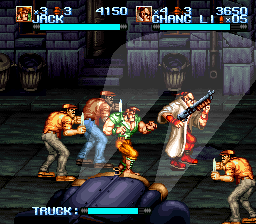
Iron Commando: fun and creative
Carlo Perconti:
What happened is that Sony broke off the Nintendo distribution in Europe, refusing to take the products. Without buyers and incapable of publishing them by ourselves, we had to close down Arcade Zone and interrupt undergoing developments, with profound regret. Other companies which already weighed in the balance survived and moved on to the Playstation. We were at the wrong time at the wrong transition, the one which saw Nintendo's European market become Sony's European market. This said, we bounced back well with our famous Burning Road, but it was to come much later (Editor's note: after setting up another game company, this time by the name of Toka).
Iron Commando was our achivement, it did pretty well in Japan and is still on sale (last time while strolling in Akihabara I saw it on a shelf) ! It was a thorough game with cut-scenes, bonus stages, it would have deserved a global distribution.
Lyes Belaidouni: We even made an attempt on the Atari Jaguar, the stillborn console for which we developed (without bragging) the most beautiful beat'em up with huge sprites and monumental backgrounds ! But this, alas, no one has seen it...
When looking back, what memories do you have from that period ?
Carlo Perconti: I have great memories, naturally. It was a time when everything was possible. Well, we were in a crucial period, not always to our advantage, but we've learnt a lot and done a lot, and traveled a lot too for the game shows. Lyes and I, we have fond memories.
Lyes Belaidouni: Yes, an unforgettable period, we really accomplished something. I think today it would be a lot more difficult. But my favorite memory of that time is Capcom team coming at our booth to see our game ! You live that only once.
After Arcade Zone, you founded Toka, which developed games mainly for the Playstation including a sequel of some sort to Legend. Today, you still work together for HyperDevbox, another game company founded by Mr. Perconti. What is your most recent project ?
Carlo Perconti: Our most recent project is ExZeus on the iPhone. And we are still faithful to our roots: arcade gaming, fight, action ! ExZeus is a 3D shooter like Sega's Planet Harriers (or Space Harrier) and it was well received by the fans on the iPhone. It was released 4 weeks ago. I'll give a link for those of you who are interested:
http://www.hyperdevbox.com/exzeus
Lyes Belaidouni: And who knows, maybe we'll remake Legend, the original, with the 2009 flavour.
And finally, as creators as well as gamers, what do you think of the retrogaming current ?
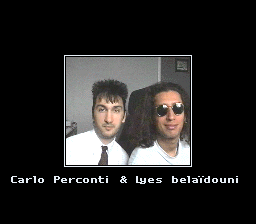
The Legend duo, in the 90's
(image from the game)
Carlo Perconti: I love it ! I think that all the new games are getting back to the solid video game concepts of those years and the ones that followed, hence retrogaming is a return to source, to the basics which made video games successful.
Lyes Belaidouni: I find this awesome, it's like opening an old photo album, emotions are still the same. Every game tells of a period of our life. I always feel the same pleasure to play it again, even though it has aged a bit of course ! Fortunately there are people like you to make the Legend live on ! ;)
All our thanks go to Carlo Perconti and Lyes Belaidouni for
kindly answering our questions in details !
| Lyes Belaidouni selective "Gamography" |
|---|
| 1990 |
Battle Storm
Crazy Cars 3
|
| 1991 |
Prehistoric Man
|
| 1992 |
The Blues Brothers
Super Davis Cup
Legend (SNES)
|
| 1993 |
Iron Commando (SFC)
|
| 1994 |
Nightmare Busters (SNES)
|
| 1995 |
Adidas Power Soccer (PS1)
|
| 1996 |
Burning Road (PS1)
|
| 1997 |
Explosive Racing (PS1)
Legend (PS1)
|
| 1999 |
Snow Break Extreme (PS1)
Soul Fighter (DC)
|
| 2000 |
Sky Surfer (PS2)
|
| 2001 |
Hidden Invasion (PS2)
The Flintstones in Viva Rock Vegas (PS2)
|
| 2004 |
Ultimate Pool
|



 NES
NES
 Super Nintendo
Super Nintendo
 Master System
Master System
 Mega Drive
Mega Drive
 PC Engine
PC Engine
 Neo Geo
Neo Geo




